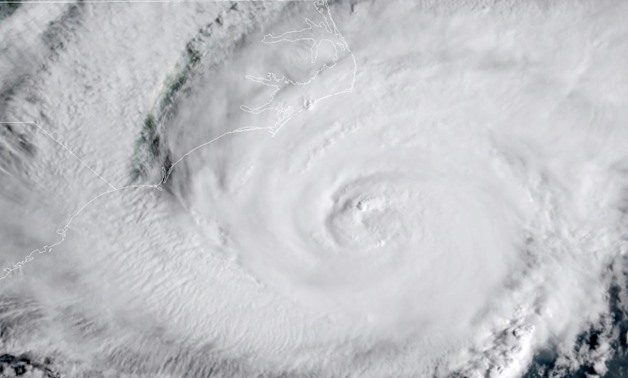
This NOAA/RAMMB satellite image shows Hurricane Florence off the US East Coast
CAROLINA - 14 September 2018: The outer edge of Hurricane Florence began buffeting the Carolinas with wind and rain on Thursday as forecasters warned the monster storm would dump copious amounts of rain on the US East Coast and cause life-threatening flooding.
As Florence churned slowly towards the coasts of North and South Carolina as a Category 2 hurricane, federal and state officials issued final appeals to residents to get out of the path of the "once in a lifetime" storm.
"This storm will bring destruction," North Carolina Governor Roy Cooper said. "Catastrophic effects will be felt."
"It's getting late to evacuate," said South Carolina Governor Henry McMaster. "You need to go on and get out now."
Federal emergency management officials warned that Florence -- while weakening a bit -- remains a "very dangerous storm" capable of wreaking havoc along a wide swathe of the East Coast.
"Just because the wind speed came down, the intensity of this storm came down to a Cat 2, please do not let your guard down," said Brock Long, the administrator of the Federal Emergency Management Agency (FEMA).
Florence was downgraded to a Category 2 storm overnight on the five-level Saffir-Simpson wind scale but it is still packing hurricane-force winds of 105 miles (165 kilometers) per hour, the National Hurricane Center (NHC) said.
"Little change in strength is expected before the eye of Florence reaches the coast, with weakening expected after the center moves inland," the Miami-based NHC said.
Winds were already picking up along the coastline on Thursday morning and some minor flooding was reported on the Outer Banks of North Carolina and in some coastal towns.
Myrtle Beach was virtually deserted with empty streets, boarded up storefronts and very little traffic.
"I was feeling fine until I woke up this morning and this is a ghost town," said Kristin Beard, a 40-year-old Myrtle Beach marketer. "I'm going to Charlotte."
US television networks said 7:00 pm to 7:00 am curfews had been put in place in several towns surrounding Myrtle Beach.
- Monster storm surge expected -
At 2:00 pm (1800 GMT), Florence was over the Atlantic Ocean about 145 miles (230 kilometers) east-southeast of Wilmington, North Carolina, and moving northwest at 10 miles per hour, the NHC said.
Steve Goldstein of the National Oceanic and Atmospheric Administration said Florence's forward motion had slowed overnight and it was not expected to make landfall in the Carolinas until "sometime Friday afternoon, Friday evening or Saturday morning."
He said hurricane-force winds extend outward 80 miles from the center of the storm and tropical storm-force winds extend nearly 200 miles out.
A storm surge of nine to 12 feet (2.7-3.6 meters) was expected along the North Carolina coast, Goldstein said, and some areas could receive as much as 40 inches (one meter) of rain.
"This rainfall will produce catastrophic flash flooding and prolonged significant river flooding," the NHC said.
A tornado watch was also in effect for parts of North Carolina.
"This is a very dangerous storm," said FEMA's Long, urging people still in evacuation zones to heed orders to flee to safer ground.
"Your time is running out," he said.
Long said the danger was not only along the coast. "Inland flooding kills a lot of people, unfortunately, and that's what we're about to see," he said.
About 1.7 million people in North Carolina, South Carolina and Virginia are under voluntary or mandatory evacuation orders and millions of others live in areas likely to be affected by what officials called a "once in a lifetime" storm.
South Carolina ordered the mandatory evacuation of one million coastal residents while North Carolina ordered an evacuation of the Outer Banks, barrier islands that are a popular tourist destination.
In Virginia, 245,000 coastal residents were ordered to evacuate.
A state of emergency has been declared in five coastal states: North Carolina, South Carolina, Georgia, Maryland and Virginia and the US capital Washington.
Duke Energy, a power company in the Carolinas, estimated that one million to three million customers could lose electricity because of the storm and that it could take weeks to restore.
"We call them disasters because they break things," said FEMA's Long. "The infrastructure is going to break, the power is going to go out."
- 'Catastrophic effects' -
Not everybody was heeding orders to evacuate, however.
Antonio Ramirez, a construction worker from El Salvador living in Leland, North Carolina, said he planned to ride out the storm with his dog Canelo.
"The shelters are not taking dogs," Ramirez said. "I'm not leaving him here.
"But I'm not afraid," he said. "We're ready and God will watch over us."
In Wilmington, residents who had decided not to evacuate were lining up to get ice from a vending machine -- $2 for a 16-pound (7.2-kilo) bag.
"I have no generator," said Petra Langston, a nurse. "I learned from the past to keep the ice in the washing machine."
Avair Vereen, 39, took her seven children to a shelter in Conway High School.
"We live in a mobile home so we were just like 'No way,'" she said. "If we lose the house, oh well, we can get housing."
"But we can't replace us so we decided to come here."

Comments
Leave a Comment